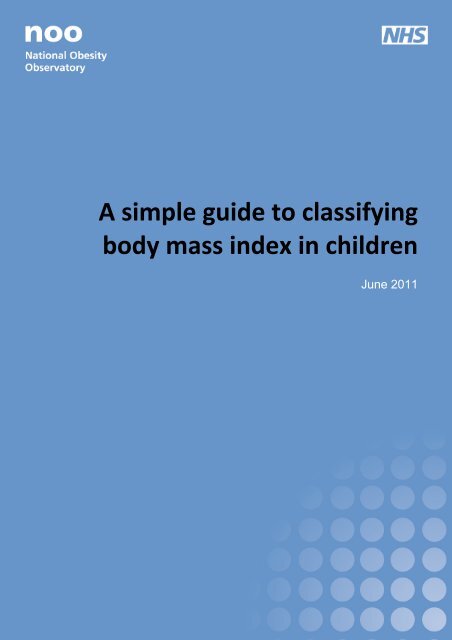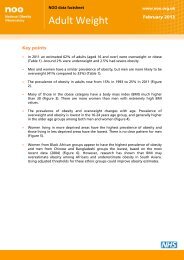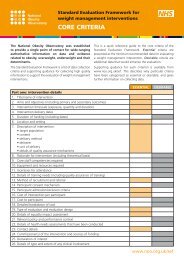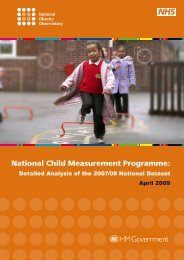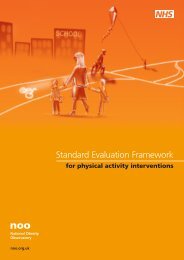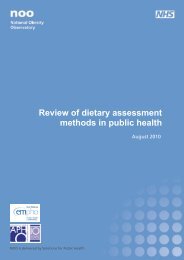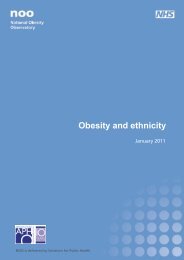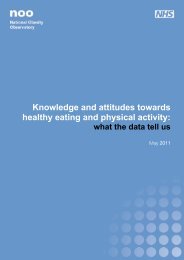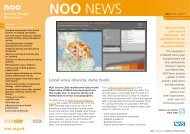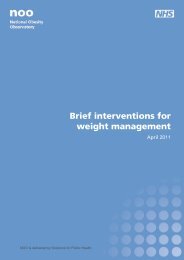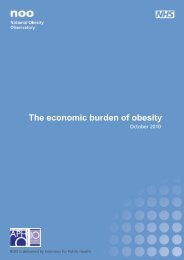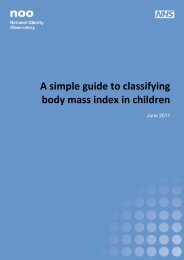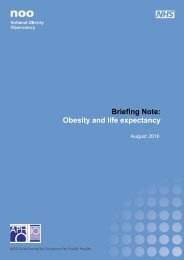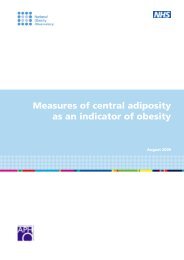A simple guide to classifying body mass index in children - National ...
A simple guide to classifying body mass index in children - National ...
A simple guide to classifying body mass index in children - National ...
- No tags were found...
You also want an ePaper? Increase the reach of your titles
YUMPU automatically turns print PDFs into web optimized ePapers that Google loves.
Delivered by NOO on behalf of the Public Health Observa<strong>to</strong>ries <strong>in</strong> EnglandNOO | A <strong>simple</strong> <strong>guide</strong> <strong>to</strong> <strong>classify<strong>in</strong>g</strong> <strong>body</strong> <strong>mass</strong> <strong><strong>in</strong>dex</strong> <strong>in</strong> <strong>children</strong> 1
What is the purpose of this paper?This paper provides a <strong>simple</strong> <strong>guide</strong> <strong>to</strong> how <strong>body</strong> <strong>mass</strong> <strong><strong>in</strong>dex</strong> (BMI) can be used <strong>to</strong> assess theweight status of <strong>children</strong>. It describes the different methods that can be used <strong>to</strong> <strong>in</strong>terpretBMI <strong>in</strong> <strong>children</strong> and young people, expla<strong>in</strong>s how the methods differ, and where eachmethod is commonly used.Why do we use BMI?• BMI provides a good <strong>in</strong>dica<strong>to</strong>r for levels of <strong>body</strong> fat. Hav<strong>in</strong>g a BMI that is either <strong>to</strong>olow or <strong>to</strong>o high is associated with an <strong>in</strong>creased risk of ill health.• BMI is relatively cheap <strong>to</strong> obta<strong>in</strong> and easy <strong>to</strong> calculate. As a result it is used forpopulation surveys and by health professionals when assess<strong>in</strong>g <strong>in</strong>dividual patients.• BMI is therefore the most frequently used measure for assess<strong>in</strong>g whether adults or<strong>children</strong> are obese, overweight, underweight, or a healthy weight.Why is BMI classification different for <strong>children</strong> and adults?• The BMI of adults rema<strong>in</strong>s relatively constant, regardless of age, unless they ga<strong>in</strong> orlose a lot of weight. When <strong>classify<strong>in</strong>g</strong> the BMI of adults it is possible <strong>to</strong> use the samecategories (also called thresholds, or cut‐offs) for def<strong>in</strong><strong>in</strong>g underweight, overweigh<strong>to</strong>r obesity, regardless of the age and sex of the adult.• Adults (aged 18 years and above) of all ages are usually classified as obese if theirBMI exceeds 30kg/m², or overweight if their BMI is greater than 25kg/m². Individualswith a BMI of less than 18.5kg/m² are usually considered underweight.• Assess<strong>in</strong>g the BMI of <strong>children</strong> is more complicated than for adults because a child’sBMI changes as they mature. Growth patterns differ between boys and girls, so boththe age and sex of a child needs <strong>to</strong> be taken <strong>in</strong><strong>to</strong> account when estimat<strong>in</strong>g whetherBMI is <strong>to</strong>o high or <strong>to</strong>o low.• Because the relationship between a child’s BMI and the level of fatness changes overtime, fixed thresholds such as those used for adults should not be applied <strong>to</strong> <strong>children</strong>as they would provide mislead<strong>in</strong>g f<strong>in</strong>d<strong>in</strong>gs.How is child BMI classified?• Instead of us<strong>in</strong>g fixed BMI thresholds <strong>to</strong> classify <strong>in</strong>dividuals (as used for adults)<strong>children</strong>’s BMI is categorised us<strong>in</strong>g variable thresholds that take <strong>in</strong><strong>to</strong> account thechild’s age and sex.• These thresholds are usually derived from a reference population, known as a childgrowth reference. They are calculated by weigh<strong>in</strong>g and measur<strong>in</strong>g a large sample of<strong>children</strong> <strong>to</strong> identify how BMI varies by age and sex across the population. As well asshow<strong>in</strong>g the pattern of growth, these data also provide an average BMI for a boy orgirl at a particular age, and the distribution of measurements above and below thisvalue. This means that <strong>in</strong>dividual <strong>children</strong> can be compared <strong>to</strong> the referencepopulation and the degree of variation from an expected value can be calculated.NOO | A <strong>simple</strong> <strong>guide</strong> <strong>to</strong> <strong>classify<strong>in</strong>g</strong> <strong>body</strong> <strong>mass</strong> <strong><strong>in</strong>dex</strong> <strong>in</strong> <strong>children</strong> 2
World Health Organization (WHO) 2007 growth reference1. What is the size of the reference population, and when were the data collected?The WHO 2007 growth reference was developed us<strong>in</strong>g the same method as used for theWHO Growth Standards, but merg<strong>in</strong>g data from the cross‐sectional component of theWHO Multicentre Growth Reference Study (MGRS) (for <strong>children</strong> aged 18‐71 months)with data used for the earlier <strong>National</strong> Center for Health Statistics (NCHS)/WHO growthreference (<strong>children</strong> aged 1‐24 years).The NCHS/WHO reference was based on a sample of <strong>children</strong> of European ancestry <strong>in</strong>the United States, collected dur<strong>in</strong>g the 1960s and 1970s.The 2007 reference is available for both height and weight for age as well as for BMI.The WHO 2007 reference almost perfectly aligns with the WHO Child Growth Standardsat age five years.2. What age range of <strong>children</strong>/ young people is covered?5‐19 years.3. Where was the reference population sampled from?The WHO 2007 growth reference was derived from a comb<strong>in</strong>ation of the USA <strong>National</strong>Centre for Health Statistics 1977 pooled growth data, and the WHO Multi‐centre GrowthReference Study (MGRS) from Brazil, Ghana, Norway, India, Oman, USA.4. What BMI cut‐offs are used?WHO suggest a set of thresholds based on s<strong>in</strong>gle standard deviation spac<strong>in</strong>g.• Th<strong>in</strong>ness:
United States Centers for Disease Control and prevention (CDC) 2000 growth reference1. What is the size of the reference population and when were the data collected?The CDC 2000 growth reference was developed us<strong>in</strong>g five national health exam<strong>in</strong>ationsurveys (the <strong>National</strong> Health Exam<strong>in</strong>ation Survey (NHES) and the <strong>National</strong> Health andNutrition Exam<strong>in</strong>ation Survey (NHANES)) for girls and boys. Some limited supplementary<strong>in</strong>formation was collected from vital statistics on child birth weight, length, and headcircumference sourced from birth certificates and hospital records (1963‐1995).2. What age range of <strong>children</strong>/ young people is covered?2‐20 years.3. Where was the reference population sampled from?USA population only.4. What cut‐offs are used?The CDC 2000 growth reference def<strong>in</strong>es <strong>children</strong> as at risk of overweight and obesity iftheir BMI exceeds the 85th and 95th centiles for most rout<strong>in</strong>e assessment. The 90th and97th centiles are used for special health care requirements. The third and fifth centilesare used <strong>to</strong> def<strong>in</strong>e underweight status.5. How are these thresholds used?The CDC 2000 growth reference is primarily used <strong>in</strong> the United States.6. Where can I f<strong>in</strong>d more <strong>in</strong>formation?www.cdc.gov/nchs/data/series/sr_11/sr11_246.pdfwww.cdc.gov/growthcharts/cdc_charts.htmNOO | A <strong>simple</strong> <strong>guide</strong> <strong>to</strong> <strong>classify<strong>in</strong>g</strong> <strong>body</strong> <strong>mass</strong> <strong><strong>in</strong>dex</strong> <strong>in</strong> <strong>children</strong> 8
Reader InformationTitleAuthor(s)A <strong>simple</strong> <strong>guide</strong> <strong>to</strong> <strong>classify<strong>in</strong>g</strong> <strong>body</strong> <strong>mass</strong> <strong><strong>in</strong>dex</strong> <strong>in</strong> <strong>children</strong>Hywell D<strong>in</strong>sdaleCarol<strong>in</strong>e RidlerLouisa EllsPublication date June 2011Target audienceDescriptionHow <strong>to</strong> citeContactElectronic locationPublic Health Observa<strong>to</strong>riesPrimary Care TrustsLocal AuthoritiesA <strong>simple</strong> <strong>guide</strong> on how <strong>body</strong> <strong>mass</strong> <strong><strong>in</strong>dex</strong> (BMI) can be used <strong>to</strong>assess the weight status of <strong>children</strong>. This paper describes thedifferent methods that can be used <strong>to</strong> <strong>in</strong>terpret BMI <strong>in</strong> <strong>children</strong>and young people.D<strong>in</strong>sdale H, Ridler C, Ells L J. A <strong>simple</strong> <strong>guide</strong> <strong>to</strong> <strong>classify<strong>in</strong>g</strong> <strong>body</strong><strong>mass</strong> <strong><strong>in</strong>dex</strong> <strong>in</strong> <strong>children</strong>. Oxford: <strong>National</strong> Obesity Observa<strong>to</strong>ry,2011.<strong>National</strong> Obesity Observa<strong>to</strong>rywww.noo.org.ukncmp@noo.org.ukhttp://www.noo.org.uk/publicationsCopyright © <strong>National</strong> Obesity Observa<strong>to</strong>ry, 2011<strong>National</strong> Obesity Observa<strong>to</strong>ryNOO | A <strong>simple</strong> <strong>guide</strong> <strong>to</strong> <strong>classify<strong>in</strong>g</strong> <strong>body</strong> <strong>mass</strong> <strong><strong>in</strong>dex</strong> <strong>in</strong> <strong>children</strong> 9


